|
. The Islamic Mughal
empire, which dominated much of India and parts of Central Asia (particularly
Afghanistan) in the 16th to 19th centuries, is undoubtedly little known to
most Americans. This is despite the power and wealth of the six principal
Mughal emperors (AD 1527-1707), and the great heights they achieved in the
arts - as exemplified by the most famous Mughal monument, the Taj Mahal,
built in the Agra region of north-central India by Shah Jahan (1628-1657).
Thus, while it would be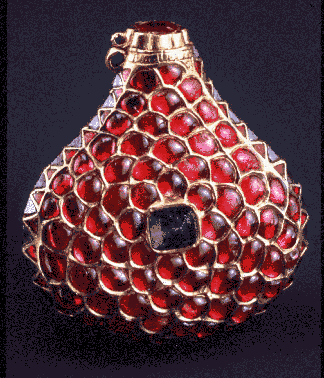 easy to tour this exhibit merely to indulge in the
brilliance and splendor of precious, gem-encrusted objects, a more careful
viewing of the over 300 works on loan from The al-Sabah Collection of the
Kuwait National Museum can also provide a rare and valuable glimpse into
the glamorous world of the Mughal courts. easy to tour this exhibit merely to indulge in the
brilliance and splendor of precious, gem-encrusted objects, a more careful
viewing of the over 300 works on loan from The al-Sabah Collection of the
Kuwait National Museum can also provide a rare and valuable glimpse into
the glamorous world of the Mughal courts.
Fig.1: Gold bottle, probably from northern India, ca. early 17th c.,
worked in kundan technique and set with rubies, emeralds, and natural diamond
crystals; 46 x 40 mm (The al-Sabah Collection, Kuwait National Museum;
photo: Edward Owen).
The exhibit is arranged rather loosely around several “themes,”
but as in the Glass of the
Sultans exhibit, what sets the objects apart most is the techniques and
materials used to create them. The exhibit opens with a display of bejeweled objects
which emphasize the great skill of Mughal craftsmen in gem-setting. The kundan
technique of fusing hyper-refined gold at room temperature was an Indian
innovation which allowed for a broad range in setting styles. One impressive
example of this technique is the extravagant dagger and scabbard of the emperor
Jahangir (1605-27), inlaid with a total of 2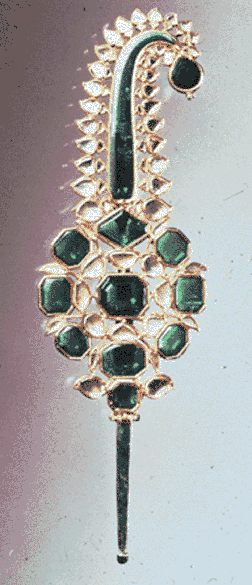 429 stones and glass shards
(including 1685 rubies, 271 unpolished diamonds, 62 emeralds, 6 agates, and
9 pieces of ivory) to form an intricate design in which trees, insects, flowers,
birds and other figures can only be detected with careful scrutiny. A small
bottle in which rubies, emeralds and diamonds are set in the form of a bursting
flower demonstrates a more subtle use of the kundan technique (fig.1).
Particularly delicate are ŕjour settings (pierced, perforated, or
openwork decorations) in which larger, high-quality stones are set without
backings so that light passes through them, in a refractive display of color
like radiant stained glass (fig.2). 429 stones and glass shards
(including 1685 rubies, 271 unpolished diamonds, 62 emeralds, 6 agates, and
9 pieces of ivory) to form an intricate design in which trees, insects, flowers,
birds and other figures can only be detected with careful scrutiny. A small
bottle in which rubies, emeralds and diamonds are set in the form of a bursting
flower demonstrates a more subtle use of the kundan technique (fig.1).
Particularly delicate are ŕjour settings (pierced, perforated, or
openwork decorations) in which larger, high-quality stones are set without
backings so that light passes through them, in a refractive display of color
like radiant stained glass (fig.2).
Fig.2: Early 17th c. gold turban ornament from India with champlevé
and overpainted enamels, worked in kundan technique and set with emeralds
and diamonds; 64 x 39 mm (photo: The al-Sabah Collection, Kuwait National
Museum).
In the same room we see examples of objects made of hardstones inlaid with
gold and gems. Such stones, including jade, are too hard to cut even with
steel edges, and require repeated grinding with a wheel and an abrasive such
as sand, with water or oil used to prevent excessive heat from friction.
The earliest such item in the exhibit is a
nephrite jade bowl from East Iran or Afghanistan, dated to the 12th century,
in which now-empty carved channels provide evidence of designs once inlaid
in gold. Many other objects, including dagger hilts and scabbards, cups,
boxe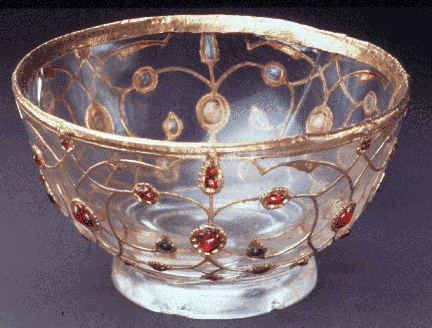 s and spoons are also of jade in various shades from white to gray-green,
inlaid with gold, often in floral designs. More unusual are objects carved
from ivory or rock crystal. The latter material was used for a small cup,
both elegant and whimsical, inlaid on the outer surface with fine trails
of gold, setting rubies, emeralds and sapphire-blue glass which are painted
to reveal tiny smiling faces on the interior of the bowl. (fig.3). s and spoons are also of jade in various shades from white to gray-green,
inlaid with gold, often in floral designs. More unusual are objects carved
from ivory or rock crystal. The latter material was used for a small cup,
both elegant and whimsical, inlaid on the outer surface with fine trails
of gold, setting rubies, emeralds and sapphire-blue glass which are painted
to reveal tiny smiling faces on the interior of the bowl. (fig.3).
Fig.3: Late 16th-early 17th c. cup carved from rock crystal of either
Deccan, or Mughal style. Inlaid with gold in kundan technique and set with
rubies, emeralds, and dark sapphire-blue glass; the stones underlain with
painted miniature faces and with kingfisher feathers. Height: 48 mm, diameter:
85 mm (photo: The al-Sabah Collection, Kuwait National Museum).
The final objects in the room highlight the “classic” phase of
Mughal goldworking, from 1600-1635/40, in which precious stones were set
flush within in a field of finely engraved gold, usually in floral and foliate
patterns. In the best of these works, such as the locket of the scabbard
to 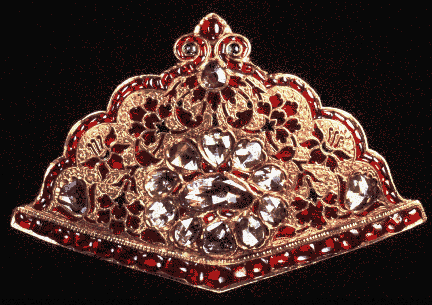 a Katar
dagger (fig.4), the stones are more than merely “set” in metal,
but both gems and gold form an integrated, complementary design. Similarly
textured precious metal can be found in a series of outstanding gold and
silver Huqqa (waterpipe) reservoirs displayed in the next room (cat. # 3.1-3.2);
like the earlier pieces they primarily feature flowing floral designs in
low relief. a Katar
dagger (fig.4), the stones are more than merely “set” in metal,
but both gems and gold form an integrated, complementary design. Similarly
textured precious metal can be found in a series of outstanding gold and
silver Huqqa (waterpipe) reservoirs displayed in the next room (cat. # 3.1-3.2);
like the earlier pieces they primarily feature flowing floral designs in
low relief.
Fig.4: Gold locket from the scabbard of a Katar dagger; worked in
kundun technique, set with diamonds, rubies, emeralds, engraved and chiseled;
India, Mughal Empire, ca. 1615-1620. Size: 56 x 83 mm (The al-Sabah
Collection, Kuwait National Museum; photo: Bruce M. White).
Floral patterns are also the most common design carved in relief on hardstones.
The graceful flowers carved onto the hilts of sharp 17th century daggers
reflect a 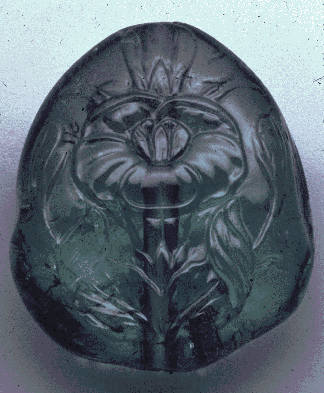 Mughal concern for both efficiency and elegance in design and
ornamentation. The carving of precious gems (also often with floral designs)
is also unique
to India; these engravers preferred to release the inner beauty of the stone
rather than hide imperfections or cut the stone to any preconceived form
(fig.5). Mughal concern for both efficiency and elegance in design and
ornamentation. The carving of precious gems (also often with floral designs)
is also unique
to India; these engravers preferred to release the inner beauty of the stone
rather than hide imperfections or cut the stone to any preconceived form
(fig.5).
Fig.5: Bored emerald from India in the 1640s; probably Mughal. Size:
37 x 33 mm (The al-Sabah Collection, Kuwait National Museum; photo: Bruce
M. White).
Other gemstones are inscribed with royal insignia. Deep red spinels were
preferred, but diamonds and emeralds were also sometimes engraved, although
often re-carved and the inscriptions lost. The inscriptions on these gems
usually commemorated royal ownership, but several of a devotional character
are known. Also of royal heritage is a “cameo” pendant carved with
the portrait of the emperor Shah Jahan (fig.6). Although cameos are known
from the region in earlier times, this phase of cameo carving seems to have
been brought to India by European jewelers employed at the Mughal court in
the first half of the 17th Century. This particular example shows a strong,
mature and bearded Jahal, bedecked in jewels, and may actually have been
made by a local artist.
European jewelers
also seemed to have introduced the technique of enameling to the Indian
subcontinent in the Mughal period. It is interesting to note that while enameled
glasswares were popular in 13th and 14th century Egypt and Syria, by the
15th century the technique was largely preserved in Europe (see exhibit review,
Glass of the Sultans), from whence it spread back east. On display are several
daggars decorated in the “early classic Mughal” enam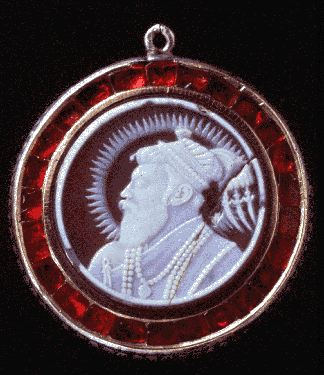 el style (cat.
# 6.16-19), in which sparkling red rossette flowers and carefully patterned
emerald green leaves are the dominant designs on an opaque white background.
While these colors continue to dominate later enamels, there are also pale
blues (pendant from ca. 1630-50; cat. # 6.24), turquoise (interior of a box
from ca. 1630-50; cat. # 6.28), pale greens (dagger and scabbard from ca.
1650-70; cat. # 6.37), and pinks (scabbard of finely painted birds and flowers,
early 18th century; cat. # 6.40). Likewise, rarely a more pictoral design
was depicted in enamel, such a scene of the Ragini Todi depicted on an archery
ring (ca. 1700; cat. # 6.47). el style (cat.
# 6.16-19), in which sparkling red rossette flowers and carefully patterned
emerald green leaves are the dominant designs on an opaque white background.
While these colors continue to dominate later enamels, there are also pale
blues (pendant from ca. 1630-50; cat. # 6.24), turquoise (interior of a box
from ca. 1630-50; cat. # 6.28), pale greens (dagger and scabbard from ca.
1650-70; cat. # 6.37), and pinks (scabbard of finely painted birds and flowers,
early 18th century; cat. # 6.40). Likewise, rarely a more pictoral design
was depicted in enamel, such a scene of the Ragini Todi depicted on an archery
ring (ca. 1700; cat. # 6.47).
Fig.6: Pendant with cameo portrait of the emperor Shah Jahan on front.
This original part, carved during the Mughal empire in the 1660’s, has
gold set in the kundan technique with rubies and a cameo (layered agate).
Its silver back was later engraved and inlaid with niello in the Deccan region
(Hyderabad) in the 19th century. Size: 37 x 33 mm (photo: The al-Sabah
Collection, Kuwait National Museum).
A loose grouping of objects which are formed in the round range from a large
silver standard of a fish and crescent to several small gem-carved birds.
An assemblage of knife-hilts, mostly of jade, end in animal heads - primarily
horses, but also a lion, ram and blue-buck - which are both life-like and
expressive. The exhibit ends with a display of “jeweled magnificence;”
i.e. heavily bejeweled objects demonstrating the peak of Mughal opulence
and design. The most interesting of these is a case for a ceremonial conch
shell, which is compactly set with an abundance of rubies, emeralds and diamonds
forming various motifs and figures. Royal, symbolic, skillfully crafted,
clever and a depository of enormous riches, the case exemplifies the best
of the Mughal arts and empire.
. Reviewed by Michele A. Miller
This article appears on pp. 81-82 in the Museum Reviews section of Vol.3, No.2 of Athena
Review.
.
|
|